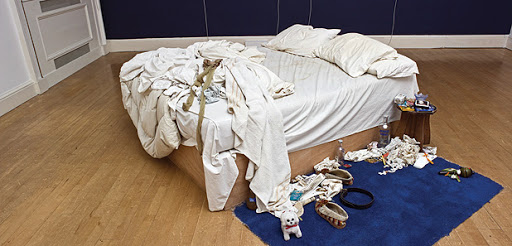"My Bed" is a 'work of art' by Brititsh artist Tracey Emin. It was shortlisted for the coveted Turner Prize and although it did not win, the notoriety of the work shot the artist to fame almost overnight. She claimed that the bed was in the same state that it had been for quite a while in her bedroom at home due to her depression.
The bed was in an unmade state and included sheets stained with human secretion while the floor around it was littered with her used knickers (stained with menstrual blood), used condoms and various items of litter as well as her used bedroom slippers all placed upon a piece of her bedroom carpet.
Although the shocking nature of the piece may raise a plethora of questions and remarks, there are two points that seem to stand out from the others:
Can this seriously be classed as art?
How can such a work be displayed in a museum or gallery (let alone someone’s home) given the decaying nature of some of the items.
In answer to the first point there are two elements to consider. Firstly, is a work of art really art when the same ‘item’ is found in various degrees of disorder in every home in the country. John Paul II in his Letter to Artists, describes the artist as having beauty as his or her vocation, and that “artistic talent” is the gift that has been bestowed upon the artist which serves the common good. Only the artist can create a work of art, therefore Emin’s unmade bed which is exactly like John Smith’s unmade bed cannot seriously be called a work of art.
However, there is another element to consider here. One could argue that such a wrok is really just a logical progression from the abstract mania of the 20th century. We live in an age that craves sensationalism as well as individualism and “uniqueness”. Once abstract art had become the established art of the day there seemed to be nowhere else to go that had not already been done before. So artists started experimenting with other forms like kinetic art (art that moves, i.e., sculptures, mainly abstract, that had moving parts), performance art (wherein the artist, and others who made up moving parts, became the work itself through movement and action) and various forms of environmental art (the artist uses elements from the surrounding environment to create an area that the viewer could walk around and be a part of. Emin’s work is really an evolution of an art form that becomes more bizarre as artists, desperate for individuality, seek for something that is recognisably theirs, in other words, everyone will recognise an Emin.
Our second point is very much connected to the first, in that, how does one exhibit such a piece long term in a gallery and how is it possible to mass produce the work commercially? Some argue that the whole point of the piece is its ‘anti-commercial’ nature. However, one can buy a print of “My Bed” on-line, albeit as a photograph, so commercialism is still part and parcel of the artist intention here. It is quite incredible that the work sold for £150,000 to Charles Saatchi to display in the Saatchi gallery, London. If we are to accept Emin’s work in the great tradition of art, then the imagination boggles at how the organic elements may be “restored’ over the ravages of time.

